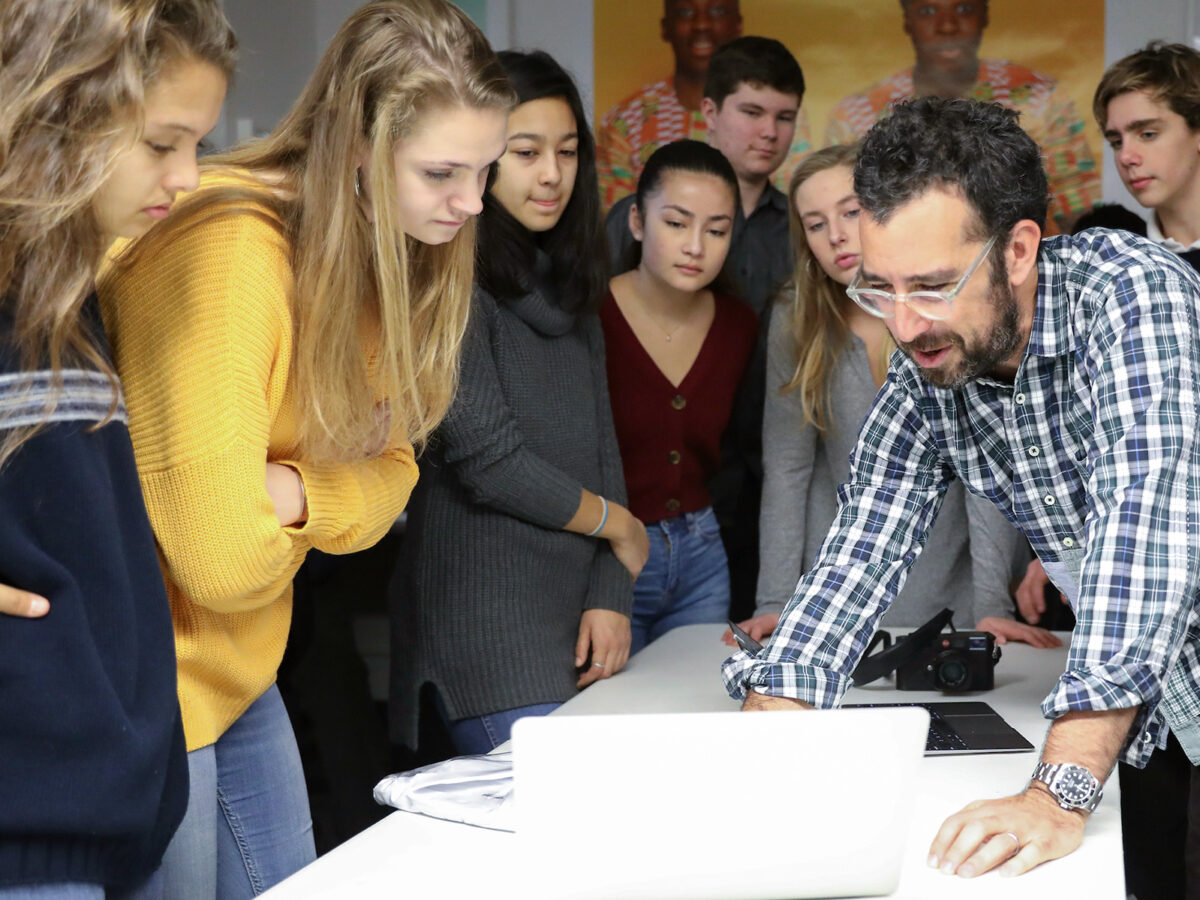Philip Andelman ’95

It was a cold call from the Cilley Hall dorm phone that landed Philip Andelman ’95 his start in a career that today boasts 43 director credits, a host of major brand commercials and three Clio awards.
As an Exeter upper, Andelman looked up the number for New York-based portrait photographer Annie Leibovitz (using 1990s technology: the White Pages) and dialed. “You mean you want to work for free?” the Leibovitz studio staffer asked. Andelman’s long-distance “Yes!” from Cilley resulted in a summerlong internship and ensuing experiences — more internships (a notable one at Columbia Pictures, where he was encouraged to ask as many questions as he wanted, including of studio executives), a film degree from NYU, a small grant from Martin Scorsese, and a lightning-fast promotion at his first job.
Over the years, the highly sought-after director kept branching out, succeeding first in music videos (see philipandelman.com for examples, including Taylor Swift, Beyoncé, The Jonas Brothers and Lenny Kravitz), then moving to commercials. His most recent venture is feature-length films: He has one underway with Lionsgate and is working on concepts for more.
During a busy two-day residency on campus in mid-December, Andelman immersed himself in Exeter life. Between visiting classes and eating meals with students, he made himself available to anyone with questions about his career and the work of making films. In response to a recurring query — How did you get to where you are today? — Andelman responded candidly that it was largely luck: being in the right place at the right time, making contacts, asking lots of questions. “Before I knew it, I had gone from fetching coffee to shooting Britney Spears and U2 videos. I was 21 years old and way in over my head. It was kind of the only way to learn. And it became like a grad school for three years.” Throughout his visit, Andelman’s joy in seeing current student work was palpable (“It’s so professional looking! Their talent is unbelievable.”).
In classes, he generously shared tips (start creating an online collection of images now and make it a habit; these can inspire projects for years to come), techniques (avoid long lenses, there’s nothing like being up close), and critiqued student work.
Here are a few scenes from the director’s visit:
Beginning photography class in Mayer Art Center
Andelman shows the music video of Taylor Swift’s “Safe & Sound” as an example of how he chooses techniques to fit a project. (He starts the creative process, he explains, by asking, “What’s right for this artist and this song?”). “I convinced her to do this thing that looked like a Danish film from the 1970s,” Andelman says, at a time when video was moving to digital. He gathered 20-year-old film stock, old cameras and lenses. The shoot took place outdoors during a freezing Tennessee December. Swift is barefoot throughout. “It took two days and her feet were blue,” Andelman explains. During one scene, as Swift walks across a stream using carefully placed rocks, “it looks like she’s walking on water,” says Andelman. That, and the old-fashioned, dreamy look, “made the video.”
As the class breaks up, a student stays late to get advice on an upcoming project: a documentary of a music concert. “The whole thing is to have a point of view,” Andelman says. “What’s going to make what you have to say about the world different? Do you know?”
“Intersectionality,” says the student. “I identify as feminist,” explaining that she wants to explore issues of sexism, racism, homophobia and transphobia in her film. “The best documentaries are the ones where the filmmakers go in expecting to tell one story and a better one unfolds before your very eyes,” says Andelman. “Hopefully your curiosity will be unique to you.”
Advanced photography class in Mayer Art Center
“It’s crucial to do storyboards,” says Andelman as he walks an advanced photography class through the process of creating commercials. “You can abandon them on your shoot, but at least everyone is on the same page. And your shoots will turn into pandemonium!” he says brightly as he projects detailed planning layouts for a New Balance campaign.
Next, Andelman presses play on the finished commercial and the students pull in closer to watch. (You, too, can watch New Balance Declare Your Independence at philipandelman. com.)
After the showing, Art Instructor Cheryle St. Onge asks about the visual transition from a skateboarder, who performs a rapid 180 twist, to a New Balance factory worker, who stitches a shoe upper with a similar movement. “Was that planned?” “No!” says Andelman. “That was my editor, the best editor in the world. … I had no idea. That is the magic.”
Andelman adds, “I hated being a photographer because everything is on you. But when you’re a director, the pressure comes off. If something is great, it’s not all you. It’s because you had a great cinematographer, a great editor, a great cast, a great production team. Coming up with ideas together is so cool.”
A classroom in Mayer Art Center
During a break between classes and an upcoming dinner with Lamont Gallery proctors, Andelman recalls his Exeter days when he convinced Theater and Dance Instructor Rob Richards to advise the fledgling film club, which still exists today. “You founded the Exeter Film Club?” asks an observer with excitement.
“Pioneers!” says Andelman.
— Nicole Pellaton
Editor’s note: This article first appeared in the winter 2019 issue of The Exeter Bulletin.